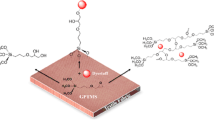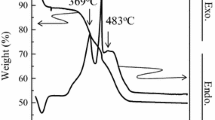Abstract
Optical sensors for application in innovative wearable sensing systems such as textile-integrated systems and wireless sensor platforms rely on the development of low-cost multifunctional materials compatible with standard fabrication technologies. We are developing optically responsive pH sensitive sol–gel coatings for integration with a mobile wireless smart tag sensing system. For this application, we have fabricated a range of thin pH sensitive films using bromocresol green (BCG) indicator immobilised in inorganic–organic silica hybrid matrices prepared by a sol–gel method and deposited by spin-coating onto glass substrates. The surface hydrophilicity of the films were varied by using the inorganic sol–gel precursor tetraethoxysilane together with either methyltriethoxysilane, ethyltriethoxysilane, phenyltrimethoxysilane or glycidoxypropyltrimethoxysilane as organically modified sol–gel precursors, co-polymerised in different ratios. Spectral characterisation of the films was performed using visible absorption spectroscopy. The shift in absorption maxima and other spectral changes of the different matrices have been identified, and the apparent pK app values of the immobilised BCG pH indicator determined. The surface wettability properties of the films have been studied by measuring the contact angle of water, formamide and diiodomethane which has allowed the estimation of the surface free energy (SFE) using three different models: Owens–Wendt, Wu and van Oss-Chaudhury-Good. It is shown that the SFE of the hybrid films is directly related to the type and the degree of organic modification, which in turn has a significant effect on the pH response-time of these sensing films.







Similar content being viewed by others
References
Curto VF, Coyle S, Byrne R, Angelov N, Diamond D, Benito-Lopez F (2012) Concept and development of an autonomous wearable micro-fluidic platform for real time pH sweat analysis. Sens Actuator B-Chem 175:263–270. doi:10.1016/j.snb.2012.02.010
Windmiller JR, Wang J (2013) Wearable electrochemical sensors and biosensors: a review. Electroanalysis 25(1):29–46. doi:10.1002/elan.201200349
Van der Schueren L, De Clerck K (2012) Coloration and application of pH-sensitive dyes on textile materials. Color Technol 128(2):82–90. doi:10.1111/j.1478-4408.2011.00361.x
von Bultzingslowen C, McEvoy AK, McDonagh C, MacCraith BD, Klimant I, Krause C, Wolfbeis OS (2002) Sol–gel based optical carbon dioxide sensor employing dual luminophore referencing for application in food packaging technology. Analyst 127(11):1478–1483. doi:10.1039/b207438a
Pacquit A, Frisby J, Diamond D, Lau KT, Farrell A, Quilty B (2007) Development of a smart packaging for the monitoring of fish spoilage. Food Chem 102(2):466–470. doi:10.1016/j.foodchem.2006.05.052
Kuswandi B, Jayus Larasati TS, Abdullah A, Heng LY (2012) Real-time monitoring of shrimp spoilage using on-package sticker sensor based on natural dye of curcumin. Food Anal Meth 5(4):881–889. doi:10.1007/s12161-011-9326-x
Mikkelsen MB, Marie R, Hansen JH, Wencel D, McDonagh C, Nielsen HO, Kristensen A (2011) Controlled deposition of sol–gel sensor material using hemiwicking. J Micromech Microeng 21:11. doi:10.1088/0960-1317/21/11/115008
Lukowiak A, Strek W (2009) Sensing abilities of materials prepared by sol–gel technology. J Sol–Gel Sci Technol 50(2):201–215. doi:10.1007/s10971-009-1952-z
Lin J, Brown CW (1997) Sol–gel glass as a matrix for chemical and biochemical sensing. Trac-Trends Anal Chem 16(4):200–211. doi:10.1016/s0165-9936(97)00021-6
Jeronimo PCA, Araujo AN, Montenegro M (2007) Optical sensors and biosensors based on sol–gel films. Talanta 72(1):13–27. doi:10.1016/j.talanta.2006.09.029
Lev O, Tsionsky M, Rabinovich L, Glezer V, Sampath S, Pankratov I, Gun J (1995) Organically modified sol–gel sensors. Anal Chem 67(1):A22–A30. doi:10.1021/ac00097a001
Collinson MM (2002) Recent trends in analytical applications of organically modified silicate materials. Trac-Trends Anal Chem 21(1):30–38
Sanchez C, Lebeau B, Chaput F, Boilot JP (2003) Optical properties of functional hybrid organic–inorganic nanocomposites. Adv Mater 15(23):1969–1994. doi:10.1002/adma.200300389
Ghazzal MN, Joseph M, Kebaili H, De Coninck J, Gaigneaux EM (2012) Tuning the selectivity and sensitivity of mesoporous dielectric multilayers by modifiying the hydrophobic-hydrophilic balance of the silica layer. J Mater Chem 22(42):22526–22532. doi:10.1039/c2jm33692h
McDonagh C, MacCraith BD, McEvoy AK (1998) Tailoring of sol–gel films for optical sensing of oxygen in gas and aqueous phase. Anal Chem 70(1):45–50. doi:10.1021/ac970461b
Lavin P, McDonagh CM, Maccraith BD (1998) Optimization of Ormosil films for optical sensor applications. J Sol–Gel Sci Technol 13(1–3):641–645. doi:10.1023/a:1008615932732
Owens DK, Wendt RC (1969) Estimation of surface free energy of polymers. J Appl Polym Sci 13(8):1741–1747. doi:10.1002/app.1969.070130815
Clifford JS, Legge RL (2005) Use of water to evaluate hydrophobicity of organically-modified xerogel enzyme supports. Biotechnol Bioeng 92(2):231–237. doi:10.1002/bit.20595
de Ferri L, Lottici PP, Lorenzi A, Montenero A, Vezzalini G (2013) Hybrid sol–gel based coatings for the protection of historical window glass. J Sol–Gel Sci Technol 66(2):253–263. doi:10.1007/s10971-013-3002-0
Zaggout FR (2005) Encapsulation of bromocresol green pH indicator into a sol–gel matrix. J Dispers Sci Technol 26(6):757–761. doi:10.1081/dis-200063087
Lobnik A, Oehme I, Murkovic I, Wolfbeis OS (1998) pH optical sensors based on sol–gels: chemical doping versus covalent immobilization. Anal Chim Acta 367(1–3):159–165. doi:10.1016/s0003-2670(97)00708-3
Kriltz A, Loser C, Mohr GJ, Trupp S (2012) Covalent immobilization of a fluorescent pH-sensitive naphthalimide dye in sol–gel films. J Sol–Gel Sci Technol 63(1):23–29. doi:10.1007/s10971-012-2757-z
Wencel D, MacCraith BD, McDonagh C (2009) High performance optical ratiometric sol–gel-based pH sensor. Sens Actuator B-Chem 139(1):208–213. doi:10.1016/j.snb.2008.12.066
Ismail F, Malins C, Goddard NJ (2002) Alkali treatment of dye-doped sol–gel glass films for rapid optical pH sensing. Analyst 127(2):253–257. doi:10.1039/b108370h
Jurmanovic S, Kordic S, Steinberg MD, Steinberg IM (2010) Organically modified silicate thin films doped with colourimetric pH indicators methyl red and bromocresol green as pH responsive sol–gel hybrid materials. Thin Solid Films 518(8):2234–2240. doi:10.1016/j.tsf.2009.07.158
Makote R, Collinson MM (1999) Organically modified silicate films for stable pH sensors. Anal Chim Acta 394(2–3):195–200. doi:10.1016/s0003-2670(99)00305-0
Wencel D, Barczak M, Borowski P, McDonagh C (2012) The development and characterisation of novel hybrid sol–gel-derived films for optical pH sensing. J Mater Chem 22(23):11720–11729. doi:10.1039/c2jm31240a
Kowada Y, Ozeki T, Minami T (2005) Preparation of silica–gel film with pH indicators by the sol–gel method. J Sol–Gel Sci Technol 33(2):175–185. doi:10.1007/s10971-005-5612-7
Markovics A, Kovacs B (2013) Fabrication of optical chemical ammonia sensors using anodized alumina supports and sol–gel method. Talanta 109:101–106. doi:10.1016/j.talanta.2013.01.054
Rottman C, Turniansky A, Avnir D (1998) Sol–gel physical and covalent entrapment of three methyl red indicators: a comparative study. J Sol–Gel Sci Technol 13(1–3):17–25. doi:10.1023/a:1008630701220
El Nahhal IM, Zourab SM, Kodeh FS, Babonneau F, Hegazy W (2012) Sol–gel encapsulation of cresol red in presence of surfactants. J Sol–Gel Sci Technol 62(2):117–125. doi:10.1007/s10971-012-2693-y
Puchberger-Enengl D, Krutzler C, Vellekoop MJ Organically modified silicate film pH sensor for continuous wound monitoring. In: Sensors, 2011 IEEE, 28-31 Oct 2011. pp 679–682. doi:10.1109/icsens.2011.6127220
Caldara M, Colleoni C, Guido E, Re V, Rosace G (2012) Development of a textile-optoelectronic pH meter based on hybrid xerogel doped with methyl red. Sens Actuator B-Chem 171:1013–1021. doi:10.1016/j.snb.2012.06.024
Kassal P, Steinberg IM, Steinberg MD (2013) Wireless smart tag with potentiometric input for ultra low-power chemical sensing. Sens Actuator B-Chem 184:254–259. doi:10.1016/j.snb.2013.04.049
Steinberg IM, Steinberg MD (2009) Radio-frequency tag with optoelectronic interface for distributed wireless chemical and biological sensor applications. Sens Actuator B-Chem 138(1):120–125. doi:10.1016/j.snb.2009.02.040
Steinberg MD, Kassal P, Tkalčec B, Steinberg IM (2014) Miniaturised wireless smart tag for optical chemical analysis applications. Talanta 118:375–381. doi:10.1016/j.talanta.2013.10.033
Metroke TL, Kachurina O, Knobbe ET (2002) Spectroscopic and corrosion resistance characterization of GLYMO-TEOS Ormosil coatings for aluminum alloy corrosion inhibition. Prog Org Coat 44(4):295–305. doi:10.1016/s0300-9440(02)00063-2
Rottman C, Grader G, Avnir D (2001) Polarities of sol–gel-derived ormosils and of their interfaces with solvents. Chem Mat 13(10):3631–3634. doi:10.1021/cm001238p
Pardo R, Zayat M, Levy D (2010) E-T(33) dye as a tool for polarity determinations: application to porous hybrid silica thin-films. J Photochem Photobiol A-Chem 210(1):17–22. doi:10.1016/j.jphotochem.2009.12.011
Reichardt C (1994) Solvatochromic dyes as solvent polarity indicators. Chem Rev 94(8):2319–2358. doi:10.1021/cr00032a005
Moreno EM, Levy D (2000) Role of the comomomer GLYMO in ORMOSILs as reflected by nile red spectroscopy. Chem Mat 12(8):2334–2340. doi:10.1021/cm001048e
Ismail F, Schoenleber M, Mansour R, Bastani B, Fielden P, Goddard NJ (2011) Strength of interactions between immobilized dye molecules and sol–gel matrices. Analyst 136(4):807–815. doi:10.1039/c0an00149j
Ye F, Collinson MM, Higgins DA (2009) What can be learned from single molecule spectroscopy? Applications to sol–gel-derived silica materials. Phys Chem Chem Phys 11(1):66–82. doi:10.1039/b812924j
Allain LR, Xue Z (2001) Hysteresis in optical sensing and its impact on the analytical error of a calibration-free acid sensor. Anal Chim Acta 433(1):97–102. doi:10.1016/S0003-2670(00)01392-1
García-Heras M, Gil C, Carmona N, Faber J, Kromka K, Villegas MA (2005) Optical behaviour of pH detectors based on sol–gel technology. Anal Chim Acta 540(1):147–152. doi:10.1016/j.aca.2004.09.031
Acknowledgments
This work was co-financed by The National Foundation for Science, Higher Education and Technological Development of the Republic of Croatia (NZZ) through the project Distributed wireless sensors for smart chemical and biological detection systems: chemo- and biosensor interface and applications development, with additional support from the Ministry of Science, Education and Sport of the Republic of Croatia (MSES) under science project Grant Number 125-0000000-3221, both of which are gratefully acknowledged. The authors would like to thank Dr Matthew D. Steinberg for helpful discussions and review of the work.
Author information
Authors and Affiliations
Corresponding author
Rights and permissions
About this article
Cite this article
Kassal, P., Šurina, R., Vrsaljko, D. et al. Hybrid sol–gel thin films doped with a pH indicator: effect of organic modification on optical pH response and film surface hydrophilicity. J Sol-Gel Sci Technol 69, 586–595 (2014). https://doi.org/10.1007/s10971-013-3261-9
Received:
Accepted:
Published:
Issue Date:
DOI: https://doi.org/10.1007/s10971-013-3261-9




